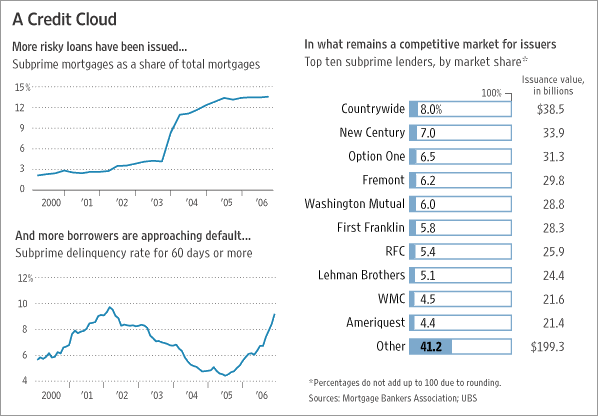---
Feb 20,2007
By Bonddad
bonddad@prodigy.net
I finally broke down and violated my "I refuse to pay for anything on the internet" policy. OK -- I bought a subscription to the Online version of the Wall Street Journal and Barron's (not exactly the most exciting material). But, outside of the editorial page the WSJ does some great economic writing. Below is an excerpt from this story (subscription required) that provides an excellent overview of the sup-prime real estate market.
Why did subprime loans get so popular? Subprime loans made up 12.75% of the $10.2 trillion mortgage market in 2006, up from 8.5% in 2001, according to Inside Mortgage Finance. The homeownership rate has grown to 69% from 65% over the past decade, about half of which came from subprime lending, according to a study by the Federal Reserve Bank of Chicago.
First, note the big increase in sub-prime loans. Over $1 trillion in sub-prime loans are out on the market right now. That's 7.6% of total US GDP.
Let's stop right there because these points raise a really interesting and difficult policy issue. I think everyone believes home ownership is a good thing. However, about half of the increase over the last few years came from sub-prime mortgage lending. Were these borrowers really able to purchase a home?
As this chart indicates, the later sub-prime loans (starting in say mid 2005) may not have been the most prudent.
Seeking new clients at a time when home values were soaring in many markets, emboldened lenders raced to offer easy credit with exotic loans, such as "piggyback" loans requiring no down payment and "no-doc" loans that let borrowers state their incomes without supporting documentation.
The increased sophistication of loan products also raises very tricky policy issues. Were consumers aware of all the important details? Did lenders provide all the relevant facts? The answer is probably somewhere in between the consumer's and the lender's areas.
Recent Senate hearings on Predatory lending indicates there are some problems within the industry.
Subprime lenders charge higher interest rates -- sometimes four percentage points more than on loans to more credit-worthy borrowers. Investors, eager for bigger returns, have fueled demand by purchasing securities that are backed by these mortgages. That has enabled many mortgage originators to turn around and sell their loans after making them, enabling more loans and reducing their risk.
Here's a short version of how this works. After a lender makes a loan, be sells the loan to another finance company. that company then packages the loan with similar loans (loans that have the same maturity, interest rate etc..) in a pool. That pool is then sold to investment concerns -- mutual funds, insurance companies etc.... Because the sub-prime mortgages have a higher interest rate, investors demanded more. As demand increased, lenders make more loans, and the cycle continued.
Now this pooling of mortgages -- if done properly -- does help to diversify risk. For example, if there is one bad loan grouped with 10 good loans, the bad loan will have a smaller impact on the pool. However, if there are 10 loans in a pool and 7 are bad, then the whole pool is in trouble. In other words, the spreading of risk only works if the risk is actually spread.
But once home prices started dropping, some borrowers began defaulting on their mortgages. One study by the Center for Responsible Lending predicts that as many as one out of every five subprime borrowers who took out reduced payment or low-documentation loans between 1998 and mid-2006 could lose their homes.
As the chart above illustrates, foreclosures for ARMs are increasing at high rates. The WSJ article noted:
Foreclosure rates on "subprime" loans -- those made to borrowers with poor credit records -- more than doubled last year from 2005, according to a UBS report. Some firms that specialized in those loans now face large losses or even bankruptcy.
According to the Implode-o-meter website, 23 lenders have now gone "kaput".
There are a few other interesting facts at the end of the article:
• Nearly 1.2 million foreclosure filings were reported last year, a 42% rise from 2005. That is a rate of one in every 92 U.S. households.
• Colorado, Georgia and Nevada had the nation's highest foreclosure rates last year, according to RealtyTrac. Among the top 100 metropolitan areas, Detroit, Atlanta and Indianapolis topped the list.
• About 80% of subprime mortgages today are adjustable-rate mortgages, or ARMs, that have been nicknamed "exploding ARMs" because they have low fixed-interest payments in their first few years but then usually adjust to higher interest payments.
• Creative new subprime loans -- "piggyback," "interest-only," and "no-doc" loans, among others -- accounted for 47% of total loans issued last year. At the start of the decade, they were less than 2% of total mortgage loans.
• Borrowers have never been more leveraged. Loan-to-value ratios, the loan amount expressed as a percent of the property value, have grown to 86.5% last year from 78% in 2000.
The facts -- as we know them now -- indicate later made sub-prime loans probably shouldn't have been made. The underwriting standards simply weren't strong enough and the borrowers simply didn't have the credit quality for those loans to be a considered good. Hopefully the spreading of default risk will minimize the problems these defaults may cause. But we'll have to wait and see for that to play out.
For economic and market commentary and analysis, go to the Bonddad Blog

No comments:
Post a Comment